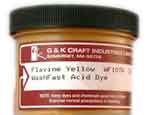I have a wool and camel hair coat I'd like to dye a darker brown
I have a wool and camel hair coat I'd like to dye a darker brown
Name: Tonya
— ADVERTISEMENTS —
Acid Dyes
Washfast Acid dyes
at Paradise Fibers

Washfast Acid dyes
Designed to permanently dye protein fibers -- animal fibers like wool, silk, angora, mohair, alpaca and nylon. These brilliant shades are carefully selected from available super milling and premetalized colors. They have excellent wash and light fastness properties.

(For wool, cashmere, angora, mohair, silk, & nylon)
Lanaset dyes
are the most washfast of all dyes for protein fibers. Rich, deep colors.Buy from
at Paradise Fibers

Washfast Acid dyes
Designed to permanently dye protein fibers -- animal fibers like wool, silk, angora, mohair, alpaca and nylon. These brilliant shades are carefully selected from available super milling and premetalized colors. They have excellent wash and light fastness properties.

(For wool, cashmere, angora, mohair, silk, & nylon)
Lanaset dyes
are the most washfast of all dyes for protein fibers. Rich, deep colors.Buy from
Country or region: USA
Message: I have a coat that is 60% camel hair & 40% wool. It's a camel color but I would like to dye it a darker brown, like chocolate, maybe. I don't know what dye to use or how to go about dyeing it once I get the right kind of dye. HELP!!!!
The first and most important question: is the coat washable? You cannot dye anything that you cannot wash. If you're not sure whether or not the coat will survive washing, decide whether you want to take the risk, and then, if so, go wash the coat first. You must always prewash anything that you are going to dye, to reduce the chance that an invisible stain will repel the dye and leave a splotch that is lighter in color. Wool can handle water, even hot water, but it should not be subjected to agitation, rough stirring, or sudden changes in temperature.
If you have successfully washed your coat, you can then consider dyeing it. Both camel hair and wool are animal fibers, which means that they are made of protein. Protein fibers should be dyed with a type of dye called acid dye. You can mail-order special high-quality dyes, or you can look for locally sold dyes that contain acid dyes.
All-purpose dyes, such as Rit, are easy to find in local stores, and contain acid dye, in addition to another type of dye that just washes out of animal-based fibers. The main drawbacks to Rit are that each box contains very little dye, so you will have to buy several boxes, which makes it more expensive than many higher-quality mail-order dyes, and that the color it produces is not always predictable. Many dyers have complained, for example, of using a black Rit dye, only to end up with something colored dark purple. For dark colors, more dye than the box's label suggests is often needed. All-purpose dyes are also not very resistant to fading during washing, but will stay dark longer if you usually dry-clean instead of washing.
While your coat is still completely dry (it goes without saying that it should be air-dried, not machine-dried), before washing it, weigh it. If you don't have a suitable scale for several-pound weights, try a post office scale, or try weighing yourself on a bathroom scale, with and without the coat, trying several times and averaging the results together. If the coat weighs four pounds, you will probably need eight boxes of all-purpose dye to color it. If you mail-order a better quality of acid dye, then carefully follow the manufacturer's instructions for how much dye to use per pound of fabric.
The best way to dye wool is in an extremely large cooking pot, but it seems unlikely that you have one large enough, especially one that you are willing to sacrifice for use as a dyeing pot. You should not plan on reusing a dyeing pot for food preparation, and the pot should be made of a non-reactive material, either stainless steel or enamel. The pot needs to be large enough for the coat to move in freely, or the color produced will not be even.
If you don't have a suitable dyeing pot then you can consider using a top-loading washing machine. Washing machine dyeing is inferior to stovetop dyeing, for protein fibers such as wool and camel hair, but in this case it may be your only realistic option. Since it's important to avoid excessive agitation on wet wool, which will caused the surface of the wool to mat and felt, you should use only a machine that has a super-delicate 'hand wash' setting, or a presoak setting. Since acid dyes work much better at high temperatures, it would be best if you can turn up the temperature on your water heater a bit for the duration of your dyeing, then turn it down again to avoid the risk of scald burns in household usage. Decide for yourself whether you want to do this.
All acid dyes work best on animal fibers in the presence of an acid, such as vinegar, and the acid dye in all-purpose dye is no exception. Although adding vinegar to Rit dye is utterly useless for cotton, it is important for wool and camel hair. You will want to buy a large bottle of distilled white vinegar from the grocery store. It should be labeled "5% acidity", which means that it contains 5% acetic acid, by weight.
To dye in the washing machine, you should get a good recipe for the specific dye you are using, and follow it closely. See my page, "How can I dye clothing or fabric in the washing machine?". Here is a link to the Jacquard Products instruction sheet for using Jacquard Acid dyes in the washing machine. Note that it says to add one cup of vinegar to the washing machine, and that there is a chart included explaining how much of each color of Jacquard Acid Dye to use for dyeing one pound of fiber. (Multiply this by the number of pounds your coat weighed when dry.) The chart says to use up to three ounces of brown dye per pound of fabric.
I believe that the Rit dye instructions omit any mention of vinegar, but, if you choose to dye wool and camel hair with any dye, using an acid such as vinegar is important. Add a cup of vinegar, just as in the Jacquard instructions. Here is a link to the instructions for washing machine instructions for Rit all-purpose dye. You must minimize agitation, and avoid sudden temperature changes. If you are not very careful, your coat may shrink or get a matted, felted surface. When you dye your own clothing, you have to take the risk of damaging your fabric, and there is a far greater risk when dyeing wool than when dyeing cotton.
After using any dye, it is important to wash out the excess unattached dye, as otherwise the dry dye will rub off onto anything it touches. Be careful to change the temperature of your rinsing water only gradually.
I hope this works for you. There is always a bit of a risk when overdyeing a commercially-produced garment, but if you are careful, it can work well. It's best to dye only those garments that you don't value much in their undyed state, since there are things that can go wrong in dyeing commercially-produced clothing.
Posted: Friday - December 17, 2010 at 11:34 AM
Follow this blog on twitter here.
Quick Links
- All About Dyes & Dyeing Top -
- Top of this blog -
- FAQ -
- The Dye Forum -
- How to Tie Dye - How to Batik -
- Books - Toys - Plants -
- Top of this blog -
- FAQ -
- The Dye Forum -
- How to Tie Dye - How to Batik -
- Books - Toys - Plants -
More in this category:
- -
Statistics
Total entries in this blog:
Total entries in this category:
Published On: Aug 29, 2012 02:49 PM
Total entries in this category:
Published On: Aug 29, 2012 02:49 PM